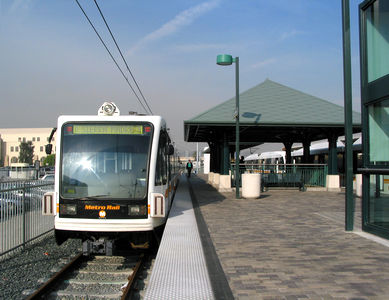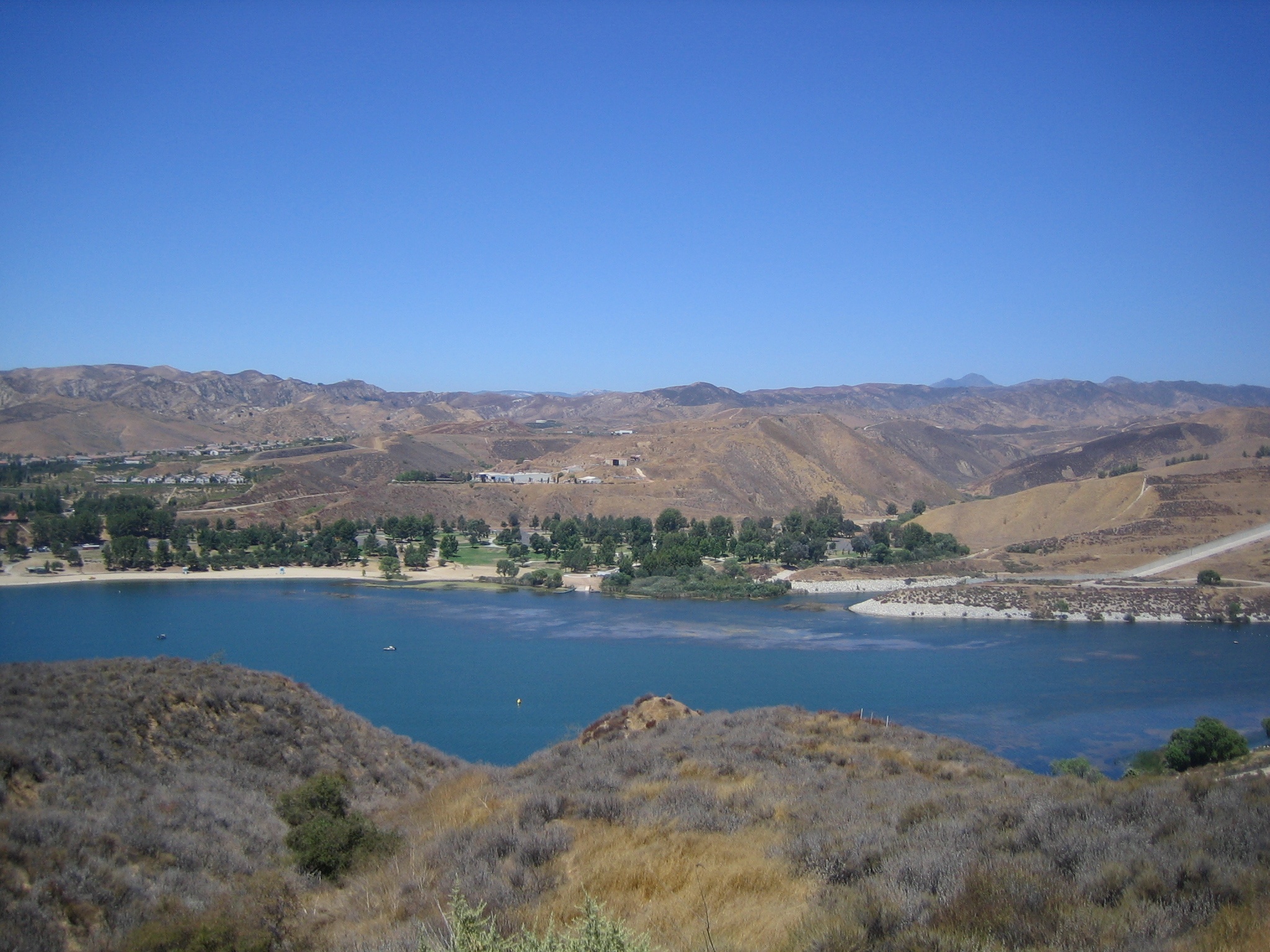|
Metropolitan Water District Of Southern California
The Metropolitan Water District of Southern California is a regional wholesaler and the largest supplier of treated water in the United States. The name is usually shortened to "Met," "Metropolitan," or "MWD." It is a cooperative of fourteen cities, eleven municipal water districts, and one county water authority, that provides water to 19 million people in a service area. It was created by an act of the California State Legislature in 1928, primarily to build and operate the Colorado River Aqueduct. Metropolitan became the first (and largest) contractor to the State Water Project in 1960. Metropolitan owns and operates an extensive range of capital facilities including the Colorado River Aqueduct which runs from an intake at Lake Havasu on the California-Arizona border to its endpoint at the Lake Mathews reservoir in Riverside County. It also imports water supplies from northern California via the California Aqueduct as a contractor to the State Water Project. In 1960, Metr ... [...More Info...] [...Related Items...] OR: [Wikipedia] [Google] [Baidu] |
Water District
A water district is a special district given the task of supplying water and sewer needs to a community. This term is commonly used in the United States. See also * Irrigation district * Drinking water supply and sanitation in the United States * Fresh water supply district A fresh water supply district is a body which manages fresh water supply in a defined area in the United States. It may have the power of eminent domain. The term fresh water supply district is mostly used in Texas, while water district is used i ... References Water supply Water and politics Water management authorities {{geo-term-stub ... [...More Info...] [...Related Items...] OR: [Wikipedia] [Google] [Baidu] |
Union Station (Los Angeles)
Los Angeles Union Station is the main railway station in Los Angeles, California, and the largest railroad passenger terminal in the Western United States. It opened in May 1939 as the Los Angeles Union Passenger Terminal, replacing La Grande Station and Central Station. Approved in a controversial ballot measure in 1926 and built in the 1930s, it served to consolidate rail services from the Union Pacific, Santa Fe, and Southern Pacific Railroads into one terminal station. Conceived on a grand scale, Union Station became known as the "Last of the Great Railway Stations" built in the United States. The structure combines Art Deco, Mission Revival, and Streamline Moderne style. It was placed on the National Register of Historic Places in 1980. Today, the station is a major transportation hub for Southern California, serving almost 110,000 passengers a day. It is by far the busiest train station in the Western United States; it is Amtrak's fifth-busiest station, and is the ... [...More Info...] [...Related Items...] OR: [Wikipedia] [Google] [Baidu] |
Lake Skinner
Skinner Reservoir, also known as Lake Skinner, is a reservoir in western Riverside County, California, located at the foot of Bachelor Mountain in the Auld Valley, approximately northeast of Temecula. It was created in 1973 by the construction of the Skinner Clearwell Dam (expanded 1991) on Tucalota Creek, and currently has a capacity of . Located north of Rancho California Road near the Temecula Valley Wine Country, The address of the reservoir is: 37701 Warren Road, Temecula, CA 92592. Lake Skinner is operated by the Riverside County Regional Park and Open-Space District (RivCo Parks), under lease by the Metropolitan Water District of Southern California. It is supplied by the Colorado River Aqueduct and the State Water Project, and feeds the Robert A. Skinner filtration plant, which provides treated water to 2.5 million people in Riverside and San Diego Counties. It is named after Robert A. Skinner, general manager of the Metropolitan Water District from 1962 to 1967, who was ... [...More Info...] [...Related Items...] OR: [Wikipedia] [Google] [Baidu] |
Inland Feeder
The Inland Feeder is a high capacity water conveyance system that connects the California State Water Project to the Colorado River Aqueduct and Diamond Valley Lake. The Metropolitan Water District of Southern California designed the system to increase Southern California's water supply reliability in the face of future weather pattern uncertainties, while minimizing the impact on the San Francisco Bay/Sacramento–San Joaquin River Delta environment in Northern California. The feeder takes advantage of large volumes of water when available from Northern California, depositing it in surface storage reservoirs, such as Diamond Valley Lake, and local groundwater basins for use during dry periods and emergencies. This improves the quality of Southern California drinking water by allowing more uniform blending of better quality water from the state project with Colorado River supplies, which has a higher mineral content. The feeder system includes three large tunnels, two running thro ... [...More Info...] [...Related Items...] OR: [Wikipedia] [Google] [Baidu] |
Chinook Salmon
The Chinook salmon (''Oncorhynchus tshawytscha'') is the largest and most valuable species of Pacific salmon in North America, as well as the largest in the genus '' Oncorhynchus''. Its common name is derived from the Chinookan peoples. Other vernacular names for the species include king salmon, Quinnat salmon, Tsumen, spring salmon, chrome hog, Blackmouth, and Tyee salmon. The scientific species name is based on the Russian common name ''chavycha'' (чавыча). Chinook are anadromous fish native to the North Pacific Ocean and the river systems of western North America, ranging from California to Alaska, as well as Asian rivers ranging from northern Japan to the Palyavaam River in the Arctic northeast Siberia. They have been introduced to other parts of the world, including New Zealand, thriving in Lake Michigan Great Lakes of North America and Michigan's western rivers, and Patagonia. A large Chinook is a prized and sought-after catch for a sporting angler. The flesh o ... [...More Info...] [...Related Items...] OR: [Wikipedia] [Google] [Baidu] |
San Francisco Bay
San Francisco Bay is a large tidal estuary in the United States, U.S. state of California, and gives its name to the San Francisco Bay Area. It is dominated by the big cities of San Francisco, San Jose, California, San Jose, and Oakland, California, Oakland. San Francisco Bay drains water from approximately 40 percent of California. Water from the Sacramento River, Sacramento and San Joaquin River, San Joaquin rivers, and from the Sierra Nevada mountains, flow into Suisun Bay, which then travels through the Carquinez Strait to meet with the Napa River at the entrance to San Pablo Bay, which connects at its south end to San Francisco Bay. It then connects to the Pacific Ocean via the Golden Gate strait. However, this entire group of interconnected bays is often called the ''San Francisco Bay''. The bay was designated a Ramsar Convention, Ramsar Wetland of International Importance on February 2, 2017. Size The bay covers somewhere between , depending on which sub-bays (such a ... [...More Info...] [...Related Items...] OR: [Wikipedia] [Google] [Baidu] |
Parker Dam
Parker Dam is a concrete arch-gravity dam that crosses the Colorado River downstream of Hoover Dam. Built between 1934 and 1938 by the Bureau of Reclamation, it is high, of which are below the riverbed (the deep excavation was necessary in order to reach the bedrock on which the foundation of the dam was built), making it the deepest dam in the world. The portion of the dam above the foundation stands tall, making it the only dam in the world that stands more underground than above ground. The dam's primary functions are to create a reservoir, and to generate hydroelectric power. The reservoir behind the dam is called Lake Havasu and can store . The dam straddles the Arizona-California state border at the narrows the river passes through between the Whipple Mountains in San Bernardino County, California and the Buckskin Mountains in La Paz County, Arizona. Power generation The power plant has four Francis turbines with a combined capacity of 120 MW. Each turbine weig ... [...More Info...] [...Related Items...] OR: [Wikipedia] [Google] [Baidu] |
Lake Havasu
Lake Havasu () is a large reservoir formed by Parker Dam on the Colorado River, on the border between San Bernardino County, California and Mohave County, Arizona, Arizona. Lake Havasu City sits on the Arizona (eastern) side of the lake with its Californian counterpart of Havasu Lake directly across the lake. The reservoir has an available capacity of . The concrete arch dam was built by the United States Bureau of Reclamation between 1934 and 1938. The lake's primary purpose is to store water for pumping into two aqueducts. Prior to the dam construction, the area was home to the Mojave people. The lake was named (in 1939) after the Mojave word for ''blue''. In the early 19th century, it was frequented by beaver trappers. Spaniards also began to mine the areas along the river. Aqueducts Mark Wilmer Pumping Plant pumps water into the Central Arizona Project Aqueduct. Whitsett Pumping Plant is located on the lake, and lifts the water for the Colorado River Aqueduct. Gene Pumpi ... [...More Info...] [...Related Items...] OR: [Wikipedia] [Google] [Baidu] |
Inland Empire (California)
The Inland Empire (IE) is a metropolitan area and region inland of and adjacent to coastal Southern California, centering around the cities of San Bernardino and Riverside, and bordering Los Angeles County to the west. It includes the cities of western Riverside County and southwestern San Bernardino County, and is considered to include the desert communities of the Coachella and Victor Valleys, respectively on the other sides of the San Gorgonio Pass and San Bernardino Mountains from the Santa Ana River watershed that forms the bulk of the Inland Empire; a much broader definition includes all of Riverside and San Bernardino counties. The combined land area of the counties of the Inland Empire is larger than ten U.S. states—West Virginia, Maryland, Hawaii, Massachusetts, Vermont, New Hampshire, New Jersey, Connecticut, Delaware and Rhode Island—and slightly smaller than the combined area of the five smallest U.S. states (New Hampshire through Rhode Island). Th ... [...More Info...] [...Related Items...] OR: [Wikipedia] [Google] [Baidu] |
Castaic Lake
Castaic Lake ( Chumash: ''Kaštiq'') is a reservoir formed by Castaic Dam on Castaic Creek, in the Sierra Pelona Mountains of northwestern Los Angeles County, California, United States, near the town of Castaic. The California Office of Environmental Health Hazard Assessment has issued a safety advisory for any fish caught in Castaic Lake and Castaic Lagoon due to elevated levels of mercury and PCBs. Description The lake, with a surface elevation of approximately above sea level, is the terminus of the West Branch California Aqueduct, though some comes from the Castaic Creek watershed above the dam. Castaic Lake is bisected by the Elderberry Forebay Dam, which creates the adjacent Elderberry Forebay. The aqueduct water comes from Pyramid Lake through the Angeles Tunnel and is used to power Castaic Power Plant, a pumped-storage hydroelectric facility on the northern end of the forebay. Water is mostly powering the turbines, rather than being pumped by them. Castaic ... [...More Info...] [...Related Items...] OR: [Wikipedia] [Google] [Baidu] |







